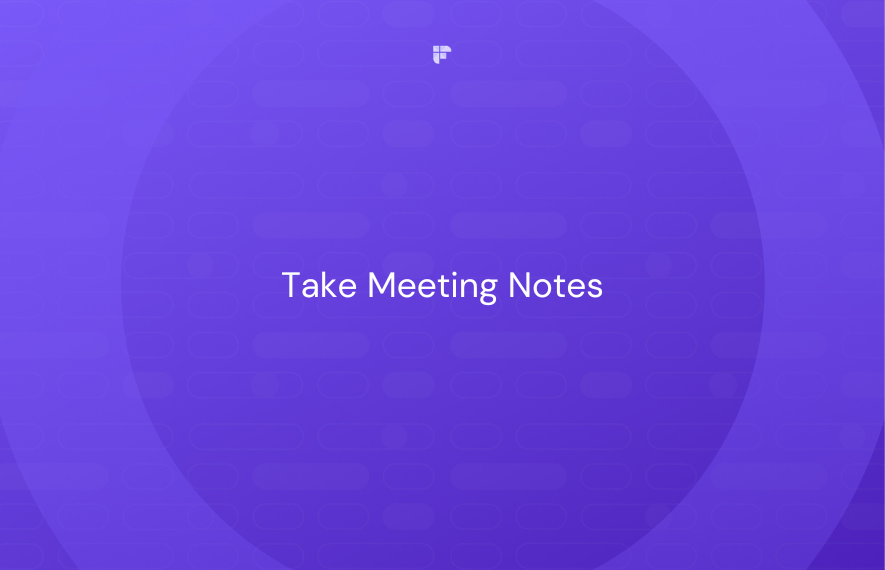Forget the age-old debate of meeting minutes vs. notes. Who says you have to choose one or the other? In fact, why not ditch both traditional methods and opt for something more modern and efficient?
Let me explain.
Scribbling down disorganized notes or spending hours formatting the perfect meeting minutes is a waste of everyone's time.
Meeting notes might be the quick way to jot down key points and action items, but it takes you out of the conversation and forces you to rely on your potentially biased interpretations and recollection. And as for meeting minutes, who has the time or energy to spend hours formatting a formal document?
It's time to embrace a new approach to meeting documentation that streamlines the process and helps your team work more effectively.
But first, for those interested in the meeting minutes vs. meeting notes debate and who want to understand which is better and how to write them (if you still must), here's some information.
What are meeting minutes?
Ready to transform your meetings from yawn-worthy time-wasters into productive powerhouses? It all starts with the magic of meeting minutes.
But what exactly are meeting minutes, you ask? Simply put, they're a written record of everything that goes down at a meeting - attendees, main points discussed, and any decisions or action items agreed upon.
These little documents are shared with everyone after the meeting so you can reference them later.
And you must share it once the meeting is over. This way, team members who couldn't make it to the meeting in person are also on the same page.
What are meeting notes?
If you want to ditch the formal transcripts and try something more relaxed, meeting notes can help.
Unlike meeting minutes, which are all about being formal and detailed, meeting notes are simple and brief notes about the essential things discussed during a meeting. Think quick jot-notes of decisions and deadlines, all captured in your own words (with some doodles on the side) without worrying about following a specific template or format.
For example, you can use "D.L." for "deadline" or use "E.g." for "example." The point is that meeting notes are super flexible and allow you to capture key moments and action items.
Meeting minutes vs. meeting notes: Key differences
Now that we've got the lowdown on meeting minutes and notes, it's time to delve into what sets them apart. Here is a head-to-head comparison between meeting notes and minutes:
Meeting Minutes:
- Formally written and include a transcript of the entire meeting
- Require a specific template
- Need to be approved after the meeting
- Distributed to all team members once the meeting is finished
Meeting Notes:
- Informal piece of text with information that a specific person thinks is important
- No need to follow a specific template
- Don't need to be approved
- Used for personal reference only
How to write effective meeting minutes
When it comes to meeting minutes, it's all about following a specific template to ensure that all the written information is easily legible for all team members.
Here's what you need to know while taking notes in meetings:
- Include the meeting's date and time (trust us, it'll come in handy later). How? Well, if your organization has a lot of meetings, you can always refer back to previous meeting minutes. Bonus points if you add the date and time of the next meeting too.
- Make sure to list the names of all participants, even if they didn't attend. This way, you can see who was present and ask them questions about specific topics.
- Clarify the general topic of the meeting, whether it's a new product launch or discussing organizational changes. Clearly state the purpose of the meeting. It's all about setting the stage for what's to come.
- List all the meeting agenda items and topics discussed. Share the schedule with everyone beforehand, so they know what to expect.
- Assign roles for the next meeting, such as host and timekeeper. Mix it up and let everyone have a turn.
- Lastly, ensure to address all documents discussed during the meeting in the minutes. You'll thank yourself later.
Here are 12 tips for taking meeting minutes effectively.
How to take better meeting notes
Meeting notes are a breeze to write compared to meeting minutes. The key to taking better meeting notes is with you. After all, it's all a matter of preference, and you don't have to follow a specific template to be effective. That being said, there are certain things you should include:
- Remember to write down the date and time of the meeting. It's a great place to start.
- If it's necessary, include the names of all participants. Just like with meeting minutes, it can be helpful to know who was present if you have any questions or doubts about something they said.
- Jot down important information like topics discussed, key questions and answers, and other crucial decisions.
- Summarize the whole meeting in a few sentences. Keep it concise, but make sure you can easily remember it later.

Why You Should Ditch Meeting Notes and Minutes
Your memory can fail you. Believe it or not, it's a fact, called the curve of forgetting.
The Curve of Forgetting
The Curve of Forgetting, also known as the Ebbinghaus Curve, was developed by the German philosopher Hermann Ebbinghaus in 1885. It demonstrates the decline in retention of new information over time if it is not continuously revisited and reinforced.

The curve shows that immediate recall of new information is at 100%, but if it is not actively reviewed and reinforced, it can decline rapidly. For example, if new information is not revisited within 24 hours, retention can decline to 60% and further to 40% after another 24 hours.
The solution? Not taking meeting notes or minutes. Why? Because these methods are no match for the fast-paced, constantly-evolving world of modern business. Meeting notes or minutes:
1. Are often inaccurate or incomplete
Meeting notes are often unorganized and may leave out important details while meeting minutes can be time-consuming to format and may not accurately capture the full conversation. This can lead to misunderstandings and miscommunications within the team.
2. Are not accessible to everyone
If meeting notes or minutes are not shared with all team members, some members may be left out of the loop on important decisions and action items.
3. Decrease productivity
When you take either meeting notes or minutes, it can be time-consuming to create and maintain, which can distract from the actual work that needs to be done.

4. Are outdated methods
Meeting notes and minutes have been the standard for documenting meetings for decades, but now more modern and efficient options are available. Using a tool that accurately records and transcribes meetings, generates customized meeting summaries, and allows for easy sharing of transcripts, you can save time and streamline the documentation process.
5. Have limited searchability
Traditional meeting notes and minutes are often written in long-form text, making it difficult to find specific information or search for keywords. Using a tool that allows you to easily search through meeting transcripts, you can quickly find what you're looking for and save time.
Be present in conversations with Fireflies
Fireflies AI Notetaker is a tool that helps overcome the challenges of traditional meeting notes and minutes. Some ways it does this include:
Accurate transcription
Fireflies AI Notetaker uses advanced artificial intelligence to transcribe meetings, ensuring that all important details are captured accurately. It eliminates the need for manual note-taking or the risk of missing important information.
It is also faster, as the tool can transcribe, allowing you to focus on the what's being said rather than typing.
Easy sharing and collaboration
Fireflies AI Notetaker allows you to easily share the transcript and summary with all team members, ensuring that everyone is on the same page and has access to the important information from the meeting.
It allows you to keep the meeting transcription private and share it with only the participants, team members, or everyone. You can also annotate the transcript, create soundbites and share it with anyone, and even mark specific points in your meeting transcripts with a thumbs up and down or pins for easy referencing.
Read how Fireflies helps disseminate better meeting notes for Purnama Outreach
Searchability
Fireflies' transcripts are fully searchable, making it easy to find specific information or keywords. Fireflies saves time and makes it easier to review past meetings. Some of the ways you can use the search function include:
Quickly finding specific information or keywords. You can enter any word or phrase into the search bar, and Fireflies AI Notetaker will return all instances of that word or phrase in the transcript or summary. It makes it easy to quickly find what you're looking for and save time.
It also includes a feature called Smart Search, system-generated AI filters that let you search for information quickly.

Smart Search includes AI filters, sentiment filters, and Topic Trackers to find what you're looking for in seconds.
AI filters allow you to search for specific words or phrases within your transcripts and summaries. For example, you can search for all the questions asked in the meeting, date and time, pricing, tasks, etc.
Sentiment filters allow you to search for positive, negative, or neutral sentiments within your transcripts.
Topic trackers allow you to track specific topics within your transcripts and summaries. For example, you can track the times a specific topic was mentioned during the meeting.
For example, let's say you want to track the discussion of a new product launch during a meeting. You can enter the product's name into the Topic Tracker, and Fireflies AI Notetaker will highlight all product mentions in the transcript.
Parting thoughts
Gone are the days of jotting down hurried notes and struggling to decipher messy handwriting. Technology has greatly improved the way we take and organize meeting notes.
With Fireflies AI Notetaker, you can rest easy knowing that your meetings are accurately and effectively documented. Plus, with the tool's sharing and collaboration features, you can easily stay up-to-date with your team and keep everyone on the same page.
So don't waste any more time in the meeting minutes vs. meeting notes debate. Make the switch to Fireflies AI Notetaker and take your meetings to the next level.







